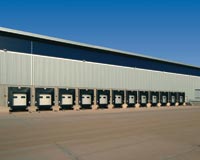Bristol is surrounded by cow country. No surprise, then, that food and farming have long been the bedrock of the Bristol logistics property market.
The city’s warehouses are the hub for a South West farming business worth £700m a year and a food and food processing sector measured in billions of pounds. Even with collapsing dairy prices – a big problem in Bristol’s hinterland – the South West is the third biggest regional food economy in the UK.
Robert Wiseman Dairies, Arla and Farm Foods – which recently moved into a new 175,000 sq ft unit developed by Roxhill and Delta Properties at Central Park, Severnside – are among the dozens of food businesses that dominate Avonmouth.
Meanwhile, third-party food distributors such as Yearsley (135,000 sq ft at Portbury, with a cold-store extension in prospect), Culina (211,000 sq ft at Prologis’ Crossflow scheme), and Co-op Food (435,000 sq ft at Avonmouth) are also big occupiers. Add in the requirements of the supermarkets, and the role of food in the region’s warehouse scene is overwhelming.
But could the food sector be about to go cold on Bristol? Last month a 500,000 sq ft Waitrose warehouse requirement was shelved as uncertainty in the grocery sector caused the upmarket chain to pause and consider. Rapid expansion of food-based distribution cannot be sustained forever – and some wonder if this could be the tipping point. A tight and increasingly supply-starved market adds extra costs and complications that some operators might prefer to avoid.
Philip Cranstone, associate director at DTZ, says many of the food distributors’ requirements are now satisfied. “There may be a few still looking but, like most of the supermarkets, they are now sorted in Avonmouth,” he says. “The exceptions are the discounters, who are still looking for space, and at the other end Waitrose, which seems to have shelved its 500,000 sq ft requirement.”
A Waitrose spokesman said it has no current requirement for a South West regional distribution centre.
Smaller third-party food distributors – often averse to medium- or long-term leases – are struggling to find space in a crowded market. “For larger distributors, Avonmouth is the obvious place to go, but if you are looking for 50,000 sq ft it is more of an issue,” says Cranstone.
“While there is a very small amount of speculative construction of around 30,000 sq ft and 40,000 sq ft buildings in Gloucester and Avonmouth, there is little evidence of other speculative development of any great scale in the South West. There is now a very real shortage of stock across all size ranges, and speculative development is unlikely to fill the void quickly enough.”
Giles Weir, director at JLL, has also noticed a pause in food-based warehouse demand. “Food has always been important in South West logistics and it has felt like there has been a surge in demand. We might see another food distributor attracted to the other half of the Crossflow unit occupied by Culina, but this has been followed by a hiatus, particularly from the supermarkets.”
Lidl is believed to have a 30-acre requirement, with a preference for buying the site, sources say. Aldi is also said to be watching the market carefully.
Andy Ridler, partner at Alder King, says: “Bristol sits in the middle of the Tewkesbury-Bridgewater-Swindon triangle and in that area the question is one of supply, not demand.”
The solution to the supply problem could come from Bristol’s eastern fringes, he suggests. Revived interest in a new M4 motorway junction promises to boost plans for as much as 1m sq ft of new development around the Emersons Green enterprise area.
Ridler adds: “It is good news that the new junction on the M4 between junctions 18 and 19 is back on the political agenda. If it is constructed it would be a positive for the eastern side of the city and would strengthen the industrial locations already there.”
North Bristol locations such as Yate will also become more appealing as Avonmouth supply tightens, he says.
So far the hoped-for surge of speculative development is just a trickle, despite take-up of industrial space in Greater Bristol of 2.6m sq ft in 2014.
Paul Hobbs, director at Bilfinger GVA, believes the South West has an excellent supply of “oven-ready” sites, such as Central Park, Avonmouth – as shown by the recent Farm Foods deal.
He says the issue is the “12-month delay to provide a building”, adding: “Occupiers will have to compromise on quality with ageing stock until the market catches up.
Businesses need to act quickly when they see something new to the market that they like, as it might not be around for long.”
Oven-ready? The South West’s food sector will be pleased to hear it. But prelets need to be cooked up soon to prevent the market going off the boil.
Speculative schemes
Speculative schemes are few and far between in the Bristol area. St Modwen has started on a speculative distribution building of 37,000 sq ft at its Access 18 scheme in Avonmouth, where it has prelet 43,100 sq ft on 3.4 acres to Hermes. Planning consent exists for two further buildings of 34,000 sq ft and 35,000 sq ft.
Chancerygate plans to invest more than £12m in a 6.5 acre scheme on the Great Western business park at Yate, after local retailer Saddleback agreed to take space at the site when it completes. A 154,000 sq ft development of 17 units is planned.
A number of developers are said to be looking for sites of up to three acres for small-unit schemes, but they are struggling to find opportunities.












